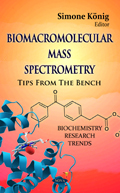Distribution of cholesterol in brain tissue as an example of TOF-SIMS analysisAnna Bodzon-Kulakowska, Andreas Kiss, Kamila Chughtai, Ron M. A. Heerenpp 1-10Abstract:TOF-SIMS is becoming popular in biological sciences due to its ability to investigate spatial distribution of molecules in tissue sections and other biological samples with a very high resolution. Here we present the example of a strategy for imaging of cholesterol in the tissue section. In this chapter some hints considering sample preparation for TOF-SIMS analysis will be presented. Additionally, the influence of different sample coating methods and technical obstacles, which may be present during analysis, will be discussed.Drug metabolism simulation using TiO2/UV systemHana Raoof, Katarzyna A. Michalow, Jerzy Silberringpp 11-20Abstract:Simulation of drug metabolites generated by photoexcitation of TiO2 by UV light in aqueous solution was performed as an important element in metabolism studies, in particular for monitoring illicit drugs and to support legal actions against drug dealers or car drivers. Metabolites of cocaine were generated, separated and identified by nanoLC-MS. The experiments proved that simulated metabolic pathways of cocaine are highly efficient and lead to the formation of metabolites that are observed using living organisms or hepatocyte microsomal preparations. Earlier studies have shown that TiO2 nanopowders are useful for complete degradation of unwanted waste to protect the environment. For the first time, we applied such a system fo rthe prediction of potential metabolites of harmful substances such as cocaine. Further studies using this methodology will assist toxicologists with a vital knowledge on metabolites derived, e.g. from newly introduced cognitive enhancers, and home-made substances prepared from over-the-counter tablets.Development of a novel ambient glow discharge plasma source for direct analysis of organic compoundsMarek Smoluch, Edward Reszke, Andrzej Ramsza, Jerzy Silberringpp 21-28Abstract:A novel atmospheric pressure glow discharge (APGD) plasma source is described. The source can be used for the analysis of organic compounds and can be considered as a soft ionization technique as no or little fragmentation is observed. Both positive and negative ion modes can be applied for sample analysis. Helium at atmospheric pressure is used as discharge gas. Sample application is possible in several ways, including direct analysis of solid compounds (for example medicine tablets), deposition on a glass slide (solution or after drying out), or paper napkin, and after nebulization. Possibility of direct analyses without any sample preparation is a main advantage of APGD source. The analytical capabilities of the source were evaluated with a quadrupole ion trap mass spectrometer.Separation of rat brain proteins for gel-based expression analysisAnna-Maria Mehlich, Andreas Rogalewski, Wolf-Rüdiger Schäbitz, Simone Königpp 29-35Abstract:Many proteomics projects require the separation of brain proteins and their differential analysis. Two-dimensional gel electrophoresis has been used for this purpose early on and is still of importance. Although many protocols are available in the literature it remains difficult to achieve good protein separation. A crucial factor for protein separation is ultracentrifugation. A step-by-step protocol is presented for differential fluorescence gel electrophoresis of rat brain proteins.Serum proteomics of cancer patients: Protein preparationAnna Drabik, Przemyslaw Mielczarek, Marek Sierzega, Jan Kuligpp 37-46Abstract:Cancer biomarkers are present in tumor tissues or body fluids, and encompass a wide variety of molecules, including DNA, transcription factors, cell surface receptors, and secreted proteins. Cancer biomarkers can be used for prognosis of the behavior of a tumor, indicating whether the outcome for the patient is likely to be good or poor prognosis. They can also help doctors to decide, which patients presumably will respond to a given drug and at what dose it might be most effective. Serum is an extremely useful sample for disease diagnosis. Plasma proteins and peptides are released from almost every tissue and cell, and their quantity alteration is specific not only to the tumor but also to the disease process itself, for example during inflammation. In addition, serum is an accessible and widely collected sample. Unfortunately, the high-abundance proteins present in serum make the identification of biomarkers really challenging using currently available techniques. Protein content in serum is dominated by highly abundant compounds, such as albumin, immunoglobulins, transferrin, and macroglobulin that constitute ca. 85% of the total sample protein composition. To detect the disease-related proteins present at very low concentrations, the most abundant proteins have to be removed first. This chapter describes strategies that have been developed to facilitate the analysis of low-abundance proteins in serum.Gel-strip sandwich technique for comparative fluorescence gel electrophoresisWeiqun Wang, Doreen Ackermann, Simone Königpp 47-59Abstract:Comparative fluorescence gel electrophoresis (CoFGE) was recently introduced to improve comparability of two-dimensional gel electrophoresis (2-DE) experiments. The technology is a combination of 1- and 2-DE termed gel-strip-sandwich (GSS) and is based on fluorescent labelling of proteins to allow multiple samples to be separated on a single gel. A gel comb forming V-wells is placed in a stacking gel – also containing the pI-strip - on top of the resolving gel. The wells provide solutions of marker proteins. During electrophoresis both the proteins from the pI-strip and the proteins from the wells are separated. Thereby, the marker proteins form a spot grid overlaying the separated proteome sample. The anchor spots allow reproducible assignment of protein spot coordinates. A step-by-step protocol for this methodology is presented below.


